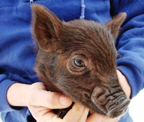
Dr. Phillip Sponenberg
Color in any breed can get contentious – especially when some colors are common and other colors are rare. The Guinea Hog is no exception!
It is important to remember (constantly) that the Guinea Hogs we know and love today are but a small sample of a once more numerous breed. Long ago I was fascinated by tales of old Southerners about the Guinea Hogs of their youth. In nearly every case the Guinea Hog was described as something VERY specific. The only thing was – the details changed from teller to teller, region to region.
The Guinea Hogs that I heard about were black, red, or blue. All three seemed to occur in the history of the breed. I think that this means that current breeders should be very slow to reject hogs of these colors, if the type and history are right.
Another issue is the white seen on some hogs. I don’t have any background stories on this, although it is unlikely that breeders would even bother to note a white foot on an otherwise colored hog. These white marks raise a host of interesting questions, but one important one is “what should breeders do about them?” It is important to remember that Guinea Hogs are very, very rare at this point. The genetic future of the breed may very well depend on increased rates of reproduction. While it is true that effective breed conservation must always emphasize the historic type, with color it is more wise to take a somewhat more lax approach. Color is relatively easy to fix later (if it needs to be), and is more of a cosmetic detail than it is the heart and core of most breeds. That is certainly true of Guinea Hogs.

Color might very well be important in deciding the fate of two otherwise similar litter mates, but if it drives decisions much beyond that then the breed will see the extinction of certain lines, and the proliferation of others. Unfortunately for the long term future of the breed, it is likely (indeed, very likely) that ALL bloodlines will be important. In that regard, it makes the most sense for breeders to focus on the type and conformation of the hogs, on assuring full representation of all bloodlines, and only then considering the color.
In the considerations of color it is best to use history as a guideline, and to realize that colors other than solid black are historically accurate for the breed. As more and more hogs are produced, it is to be expected that some of these historic colors may pop out once again. This has certainly happened in other heritage breeds – red was extinct in Randall cattle for decades, but has recently reappeared in cattle of impeccable pedigree and type. Including these has been favored by the breeders, as they feel they are recapturing even more of the traditional breed than they thought possible. The same opportunity awaits the Guinea Hog breeders as they encounter rare, historic colors in the years to come.
Who is Dr. Phillip Sponenberg?
Dr. Phillip Sponenberg, DVM, Ph.D., technical advisor to the ALBC, was kind enough to put together an article about color in guinea hogs for the AGHA.. For those of you who might not know Dr. Sponenberg, read about him at:
http://www.albc-usa.org/staff.html
Dr. Sponenberg has also written books that are worth reading and might very well become your bibles to conservation breeding. We have and refer to both books often. See/buy them here:
